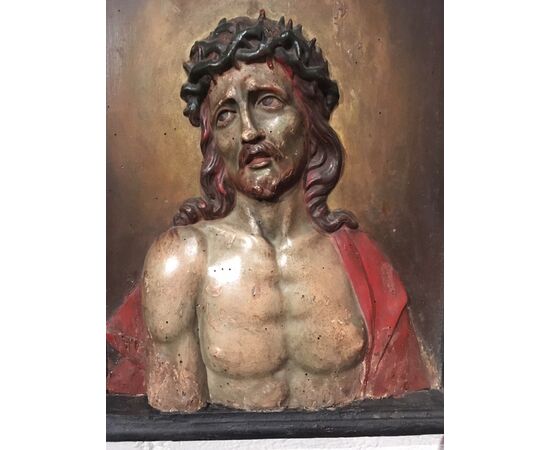RISERVATO - Ecce Homo Italia XVI° secolo
Ecce Homo
Italia XVI° secolo
cm 70X50 (in cornice coeva)
Rilievo in legno policromo raffigurante Cristo sofferente, dopo la flagellazione con il mantello purpureo sulle spalle e la corona di spine.
Ecce homo (lett. «Ecco l'uomo») è la frase che Ponzio Pilato, allora governatore romano della Giudea, pronunciò mostrando alla folla Gesù flagellato.
Secondo quanto raccontato dai Vangeli, Gesù, al momento dell'arresto, venne ritenuto innocente dal Governatore.
Questi, per calmare la plebe che voleva vedere Gesù giustiziato ugualmente, lo fece infine flagellare, pensando in questo modo di soddisfare la sete di sangue del pubblico.
Dopo la flagellazione Pilato mostrò alla folla il Cristo coperto di piaghe e ferite sanguinanti, con una corona di spine sul capo e un mantello purpureo da re sulle spalle, quindi pronunciò la frase «Ecce homo» come per dire "Guardate l'uomo, vedete che l'ho punito?".
Ciò non fu però giudicato sufficiente, e i sommi sacerdoti fecero pressione per far crocifiggere il prigioniero.
L'opera, come ogni altro nostro oggetto, sarà venduta corredata da attestato di autenticità.
Ci occupiamo e organizziamo personalmente l'imballaggio e la spedizione delle nostre opere d'arte, con assicurazione, in tutto il mondo
Nel caso l’opera venisse acquistata da clienti non italiani la stessa necessiterà dell’attestato di libera circolazione.
Lo stesso è ottenibile in 10/20 giorni lavorativi.
La galleria si occuperà degli aspetti burocratici ed economici della cosa.
Tutti i costi dell’operazione sono quindi inclusi nel prezzo.
English
Ecce Homo
Italy 16th century
70X50 cm (in contemporary frame)
Polychrome wooden relief depicting Christ suffering after the flagellation with the purple cloak on his shoulders and the crown of thorns.
Ecce homo (lit. «Behold the man») is the phrase that Pontius Pilate, then Roman governor of Judea, pronounced while showing the flagellated Jesus to the crowd.
According to what the Gospels tell, Jesus, at the time of his arrest, was deemed innocent by the Governor.
To calm down the plebs who wanted to see Jesus executed anyway, he finally had him flagellated, thinking in this way to satisfy the public's thirst for blood.
After the flagellation, Pilate showed the crowd Christ covered in sores and bleeding wounds, with a crown of thorns on his head and a purple king's cloak on his shoulders, then pronounced the phrase "Ecce homo" as if to say "Look at the man, see that I punished him?".
However, this was not considered sufficient, and the high priests pressured to have the prisoner crucified.
The work, like all our other objects, will be sold accompanied by a certificate of authenticity.
We personally take care of and organize the packaging and shipping of our works of art, with insurance, all over the world
If the work is purchased by non-Italian customers, it will require a certificate of free circulation.
The same can be obtained in 10/20 working days.
The gallery will deal with the bureaucratic and economic aspects of the matter.
All costs of the operation are therefore included in the price.
Français
Ecce Homo
Italie 16ème siècle
70X50 cm (dans cadre contemporain)
Relief en bois polychrome représentant le Christ souffrant après la flagellation avec le manteau pourpre sur les épaules et la couronne d'épines.
Ecce homo (lit. «Voici l'homme») est la phrase que Ponce Pilate, alors gouverneur romain de Judée, prononça en montrant Jésus flagellé à la foule.
D'après ce que racontent les Évangiles, Jésus, au moment de son arrestation, a été déclaré innocent par le gouverneur.
Pour calmer la plèbe qui voulait de toute façon voir Jésus exécuté, il le fit finalement flageller, pensant ainsi satisfaire la soif de sang du public.
Après la flagellation, Pilate montra à la foule le Christ couvert de plaies et de plaies sanglantes, avec une couronne d'épines sur la tête et un manteau de roi pourpre sur les épaules, puis prononça la phrase "Ecce homo" comme pour dire "Regardez l'homme". , tu vois que je l'ai puni ?".
Cependant, cela n’a pas été jugé suffisant et les grands prêtres ont fait pression pour que le prisonnier soit crucifié.
L'œuvre, comme tous nos autres objets, sera vendue accompagnée d'un certificat d'authenticité.
Nous prenons en charge et organisons personnellement l'emballage et l'expédition de nos œuvres d'art, avec assurance, partout dans le monde.
Si l'œuvre est achetée par des clients non italiens, elle nécessitera un certificat de libre circulation.
La même chose peut être obtenue en 10/20 jours ouvrables.
La galerie abordera les aspects bureaucratiques et économiques de la question.
Tous les frais de l'opération sont donc inclus dans le prix.








